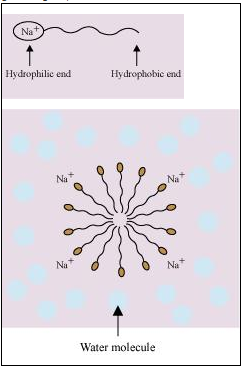Class 12 Chemistry - Chapter Surface Chemistry NCERT Solutions | What are micelles? Give an example of a
What are micelles? Give an example of a micellers system.
Micelles formation is done by substances soaps and detergents when dissolved in water.The Molecules of such substances contain a hydrophobic and a hydrophilic part. when present in water, these substances arrange themselves in spherical structure in such a manner that their hydrophobic parts are present towards the centre, while the hydrophilic parts are pointing towards outside (as shown in the given figure). This is known as micelles formation.

More Questions From Class 12 Chemistry - Chapter Surface Chemistry
- Q:-
Explain what is observed
(i) When a beam of light is passed through a colloidal sol.
(ii) An electrolyte, NaCl is added to hydrated ferric oxide sol.
(iii) Electric current is passed through a colloidal sol?
- Q:-
Why is adsorption always exothermic?
- Q:-
What do you mean by activity and selectivity of catalysts?
- Q:-
What modification can you suggest in the Hardy-Schulze law?
- Q:-
Explain the following terms:
(i) Electrophoresis
(ii) Coagulation
(iii) Dialysis
(iv) Tyndall effect.
- Q:-
What is an adsorption isotherm? Describe Freundlich adsorption isotherm.
- Q:-
Explain the terms with suitable examples:
(i) Alcosol
(ii) Aerosol
(iii) Hydrosol
- Q:-
How are colloids classified on the basis of
(i) Physical states of components
(ii) Nature of dispersion medium and
(iii) Interaction between dispersed phase and dispersion medium?
- Q:-
Discuss the effect of pressure and temperature on the adsorption of gases on solids.
- Q:-
Why does physisorption decrease with the increase of temperature
Popular Questions of Class 12 Chemistry
- Q:-
For the reaction R → P, the concentration of a reactant changes from 0.03 M to 0.02 M in 25 minutes. Calculate the average rate of reaction using units of time both in minutes and seconds.
- Q:-
Write the formulas for the following coordination compounds:
(i) Tetraamminediaquacobalt (III) chloride
(ii) Potassium tetracyanonickelate(II)
(iii) Tris(ethane-1,2-diamine) chromium(III) chloride
(iv) Amminebromidochloridonitrito-N-platinate(II)
(v) Dichloridobis(ethane-1,2-diamine)platinum(IV) nitrate
(vi) Iron(III) hexacyanoferrate(II)
- Q:-
(i) Write structures of different isomeric amines corresponding to the molecular formula, C4H11N
(ii) Write IUPAC names of all the isomers.
(iii) What type of isomerism is exhibited by different pairs of amines?
- Q:-
Why are solids rigid?
- Q:-
Write the structures of the following compounds.
(i) α-Methoxypropionaldehyde
(ii) 3-Hydroxybutanal
(iii) 2-Hydroxycyclopentane carbaldehyde
(iv) 4-Oxopentanal
(v) Di-sec-butyl ketone
(vi) 4-Fluoroacetophenone
- Q:-
Which of the ores mentioned in Table 6.1 can be concentrated by magnetic separation method?
- Q:-
Why are pentahalides more covalent than trihalides?
- Q:-
Silver atom has completely filled d orbitals (4d10) in its ground state. How can you say that it is a transition element?
- Q:-
Glucose or sucrose are soluble in water but cyclohexane or benzene (simple six membered ring compounds) are insoluble in water. Explain.
- Q:-
Write structures of the following compounds:
(i) 2-Chloro-3-methylpentane
(ii) 1-Chloro-4-ethylcyclohexane
(iii) 4-tert. Butyl-3-iodoheptane
(iv) 1,4-Dibromobut-2-ene
(v) 1-Bromo-4-sec. butyl-2-methylbenzene
Recently Viewed Questions of Class 12 Chemistry
- Q:-
Copper crystallises into a fcc lattice with edge length 3.61 x 10-8cm. Show that the calculated density is in agreement with its measured value of 8.92 g cm-3.
- Q:-
Why does NH3 form hydrogen bond but PH3 does not?
- Q:-
If the solubility product of CuS is 6 x 10-16, calculate the maximum molarity of CuS in aqueous solution.
- Q:-
The partial pressure of ethane over a solution containing 6.56 x 10-3 g of ethane is 1 bar. If the solution contains 5.00 x 10-2 g of ethane, then what shall be the partial pressure of the gas?
- Q:-
Why are Mn2+compounds more stable than Fe2+ towards oxidation to their +3 state?
- Q:-
Knowing the electron gain enthalpy values for O → O- and O → O2- as -141 and 702 kJ mol-1 respectively, how can you account for the formation of a large number of oxides having O2- species and not O-? (Hint: Consider lattice energy factor in the formation of compounds).
- Q:-
Write the monomers used for getting the following polymers. (i) Polyvinyl chloride (ii) Teflon (iii) Bakelite
- Q:-
If NaCl is doped with 10-3mol % of SrCl2, what is the concentration of cation vacancies?
- Q:-
How many lattice points are there in one unit cell of each of the following lattice?
(i) Face-centred cubic
(ii) Face-centred tetragonal
(iii) Body-centred
- Q:-
Write all the geometrical isomers of [Pt(NH3)(Br)(Cl)(py)] and how many of these will exhibit optical isomers?
2 Comment(s) on this Question
the detergent in water
Example sir..
- All Chapters Of Class 12 Chemistry
- All Subjects Of Class 12
